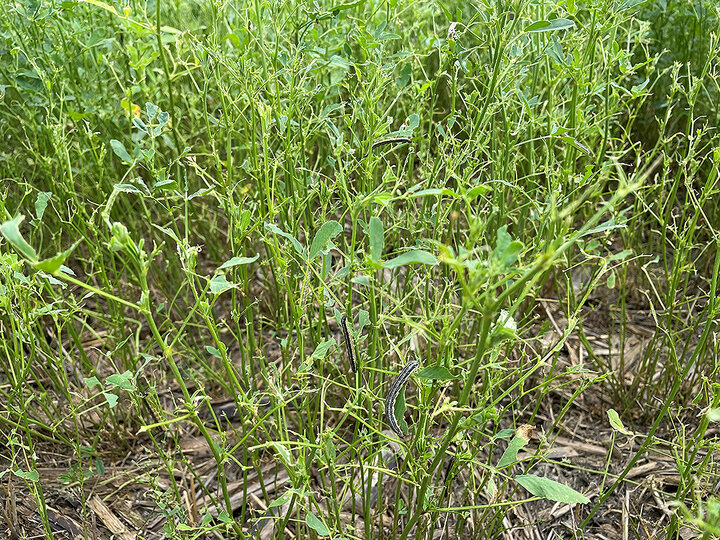Fall Armyworms in Alfalfa
Is it the very hungry caterpillar or an army of fall armyworms? Fall armyworms have been causing significant damage to some alfalfa fields in southeastern Nebraska the past few weeks. Producers have watched a nice alfalfa field be nearly completely stripped of leaves in a matter of a few days by these pests, reducing their yield substantially.

Fall armyworm caterpillars feed on a wide host of plants and they do most of their feeding in the last four days of their larvae development. Therefore, it is very important to scout fields regularly in the early morning and late afternoon when caterpillars are most active to spot these forage offenders when they are small. Once they are larger than ¾ of inch, they can do significant damage in a short amount of time.
A population of three or more caterpillars per square foot is a reasonable treatment threshold. However, the use of insecticides is not recommended unless the majority of the caterpillars are less than ¾ of an inch long. There are several insecticides labeled to control this pest in alfalfa. When considering a chemical treatment option, remember caterpillars ¾ of inch or longer are close to maturity and are tougher to control with an insecticide. In this case, cutting the alfalfa to reduce the damage might be the best management option.
The fall armyworm does not overwinter here in Nebraska. In fact, their populations build up in the south during the summer and the moths fly north, reaching us in the late summer or early fall. Fall armyworm caterpillars vary in color from light tan, green to nearly black with a darker head. Some key features of the fall armyworm are a predominantly white, inverted Y shape on its head, and four spots in the shape of a square on the end of its abdomen.
So be sure to get out and monitor your alfalfa fields.
Fall Control of Winter Annual Bromes
Was cheatgrass — sometimes called downy brome — or wild oats abundant in your pastures this spring? Although difficult, they can be controlled and your pasture revitalized.
Winter annual bromes often invade thin or overgrazed pastures in fall and early spring. Livestock dislike grazing them after they become mature and over time they can take over and make large patches in a pasture.
Recent research by the University of Nebraska evaluated herbicides for controlling cheatgrass. Products containing rimsulfuron and imazapic (Plateau®) can provide good control of cheatgrass from a single application, but control can vary widely from year to year depending on when the application is made, maturity of cheatgrass plants and the weather patterns. A one-time management operation, utilizing grazing, mowing, or a non-residual herbicide like rimsulfuron or imazapic, usually does not have a lasting impact on the cheatgrass in the seedbank. To reduce the seedbank, control needs to be close to 100%, and repeated over several years.
Rejuvra™ is a new rangeland herbicide product from Bayer that works differently from existing cheatgrass herbicides. Rejuvra™ has limited activity on emerged plants and only controls seedlings as they germinate, so it is best to apply Rejuvra™ in early fall before seeds germinate. This herbicide can provide control up to two years post-application.
In warm-season grass pastures and rangeland, there is another option. You can use glyphosate herbicides after top growth of these grasses has died due to a hard freeze or two. This can kill emerged annual brome seedlings without harming the desirable grasses. However, do not use glyphosate in cool-season pastures because it will injure or kill the pasture grasses as well. With any herbicide, always read and follow label directions.
With these herbicide options and proper grazing management, your pastures can develop thicker stands of the more desirable grasses. It takes a long, dedicated process to recover pastures overtaken by winter annual bromes.
The Last Cutting
By Brad Schick
Has the decision been made for when the last cutting of alfalfa will happen?
September is here and so are the dry conditions in much of Nebraska. When alfalfa is cut for the last time in the fall, it affects winter survival as well as the spring regrowth. As long as it is cut at the right time, the effects won’t be bad. Alfalfa needs 500 growing degree days or approximately six weeks of uninterrupted growth in the fall to fully prepare for winter by building up nutrients in the roots. This typically means that the beginning of the six weeks of growth will be about three weeks before the first frost.
The last cutting can either be before the winterization process or after. If cut during, it adds more stress to the alfalfa. During stressful years for alfalfa such as drought, insect and disease pressure, or more than four cuttings, the risk of poorer spring regrowth increases. Newer stands, winterhardy varieties and more disease-resistant varieties can typically handle more plant stress.
Another factor to consider is how badly alfalfa hay is needed. If drought has forced the hand to cut alfalfa in less-than-ideal times, the risk of cutting during the winterization process may outweigh the cost of buying expensive hay. Weather can always throw a wrench in our plans so waiting until after the winterization process to cut again would be less risky.
Any cutting of alfalfa is a stress event for the plant. Minimizing additional stress by avoiding the winterization window will help with winter survival and vigorous spring growth.
